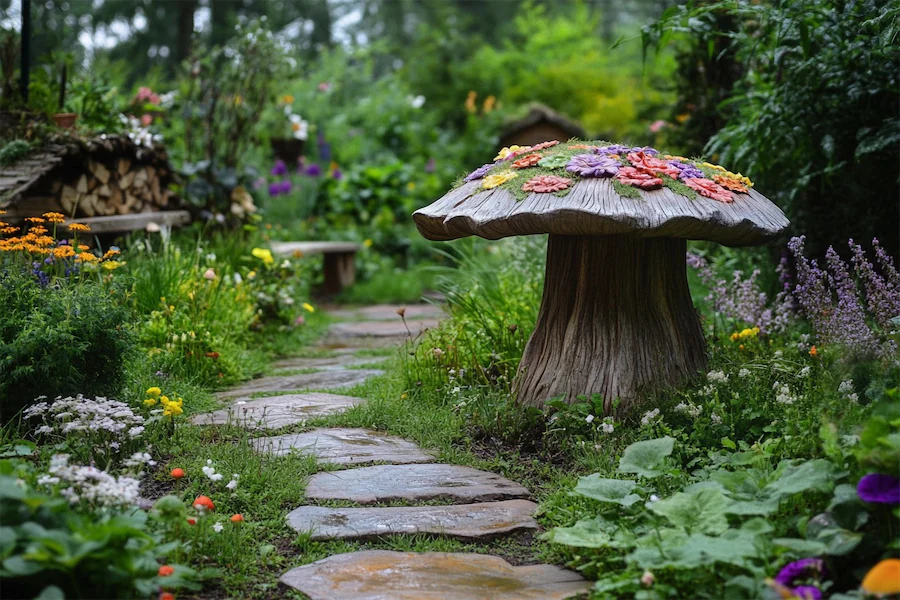A Fairy Tale Garden is a whimsical outdoor space designed to evoke the magic and wonder of classic fairy tales. By incorporating imaginative elements, lush plantings, and charming accessories, such a garden becomes a haven for both children and adults seeking enchantment in their surroundings.
History and Origins of Fairy Tale Gardens
The concept of Fairy Tale Gardens draws inspiration from the rich tradition of storytelling and the human desire to create spaces that reflect the fantastical worlds of folklore and literature. Historically, gardens have been designed to tell stories or represent mythical landscapes, serving as a canvas for artistic expression and cultural narratives. For instance, the Märchenbrunnen (Fairy Tale Fountain) in Berlin, completed in 1913, features sculptures of characters from the Brothers Grimm tales, integrating storytelling into garden design.
Key Features of a Fairy Tale Garden
- Whimsical Structures: Incorporate elements like miniature castles, fairy houses, or rustic cottages to serve as focal points. These structures can be crafted from natural materials to blend seamlessly with the environment.
- Lush, Enchanted Plantings: Utilize a variety of plants to create a lush and inviting atmosphere. Incorporate flowering plants like foxglove, lavender, and butterfly bush to add color and attract pollinators. Ground covers such as moss and creeping thyme can enhance the mystical feel, especially in shaded areas.
- Meandering Pathways: Design winding paths using materials like stone, wood, or gravel to encourage exploration and a sense of adventure. These pathways can lead to hidden nooks or secret gardens within the larger space.
- Water Features: Introduce elements like small ponds, fountains, or streams to add a soothing auditory component and reflect the magical ambiance. Water features can also serve as habitats for wildlife, enhancing the garden’s ecosystem.
- Decorative Accents: Incorporate items such as fairy figurines, toadstool sculptures, or lanterns to add character and charm. These accents can be strategically placed to surprise and delight visitors.
Applications of Fairy Tale Gardens
- Residential Spaces: Homeowners can transform parts of their yards into Fairy Tale Gardens, creating a personal retreat that fosters imagination and relaxation. These spaces can serve as play areas for children or serene spots for contemplation.
- Public Parks and Gardens: Municipalities and organizations can develop Fairy Tale Gardens to attract visitors and provide educational opportunities. Such gardens can host storytelling events, workshops, and seasonal celebrations, enriching the community’s cultural offerings.
- Therapeutic Environments: Fairy Tale Gardens can be integrated into settings like hospitals or rehabilitation centers to promote healing and well-being. The sensory experiences offered by these gardens—sights, sounds, and scents—can have calming and restorative effects.
Considerations When Designing a Fairy Tale Garden
- Theme Selection: Decide on a specific fairy tale or a general whimsical theme to guide the design process. Consistency in theme helps create a cohesive and immersive experience.
- Plant Selection: Choose plants that are suitable for the local climate and soil conditions. Incorporate a mix of perennials and annuals to ensure year-round interest. Consider plants with unique shapes, colors, or fragrances to enhance the magical atmosphere.
- Safety and Accessibility: Ensure that pathways are safe and accessible for all visitors, including children and individuals with mobility challenges. Use non-slip materials for walkways and provide adequate lighting for evening enjoyment.
- Maintenance: Design the garden with maintenance in mind, selecting low-maintenance plants and durable materials to ensure the space remains enchanting with minimal upkeep. Regular care will keep the garden healthy and visually appealing.
Conclusion
Creating a Fairy Tale Garden allows individuals to bring the enchantment of beloved stories into their own outdoor spaces. By thoughtfully combining whimsical structures, lush plantings, and imaginative accents, one can craft a garden that delights the senses and nurtures the spirit, providing a magical retreat from the everyday world.
